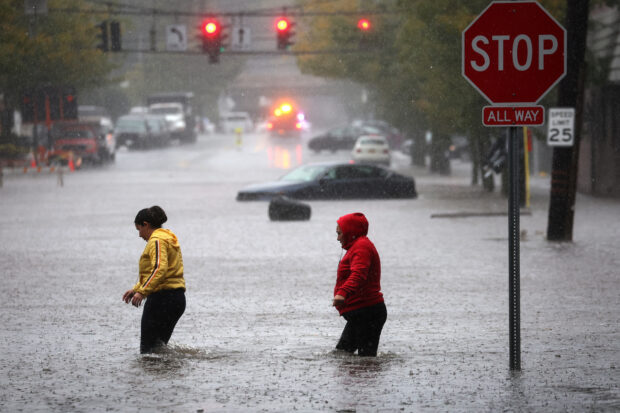New York deluge triggers flash floods, brings chaos to subways

Residents walk through floodwaters during a heavy rain storm in the New York City suburb of Mamaroneck in Westchester County, New York, U.S., September 29, 2023. REUTERS/Mike Segar
NEW YORK — Torrential downpours after a week of mostly steady rainfall brought flash flooding to New York City on Friday, disrupting subway service, inundating ground-level apartments and turning some streets into small lakes.
Almost eight inches (20 cm) of rain fell in some parts of the most populous city in the U.S., enough to enable a sea lion at Central Park Zoo to swim briefly out of the confines of her pool enclosure. Another few inches could fall in the region before the storm system pushed out to sea later on Friday, forecasters said.
New York Governor Kathy Hochul warned of “life-threatening” floods and declared a state of emergency for New York City, Long Island, and the Hudson Valley. Some National Guard troops were deployed to assist in the response.
In Mamaroneck, a Westchester County suburb north of the city, emergency officials used inflatable rafts to rescue people trapped in buildings by floods.
Flooding caused major disruptions to New York’s subway system and the Metro North commuter rail service, according to the Metropolitan Transportation Agency, which operates both. Some subway lines were suspended entirely, and many stations were closed. Some bus routes slowed to a crawl, trapping riders for hours. Officials warned some New Yorkers to avoid traveling unless they were fleeing a flooded area.
Article continues after this advertisementSystems producing intense rainfalls such as Friday’s have become more common in many parts of the U.S., including the New York City area.
Article continues after this advertisementGlobal warming has produced more extreme weather patterns in much of the world, according to climate scientists.
The rain capped one of New York’s wettest Septembers on record, with 13.74 inches (34.9 cm) of rain falling during the month as of 11 a.m. on Friday, and more on the way, said Dominic Ramunni, a National Weather Service forecaster. The all-time high was set in 1882 when 16.82 inches (42.72 cm) fell in September.
“I don’t know if we’ll beat the record, but we’ll come close,” Ramunni said.

Residents escape rising floodwaters during a heavy rain storm in the New York City suburb of Mamaroneck in Westchester County, New York, U.S., September 29, 2023. REUTERS/Mike Segar
It was the rainiest day at the city’s John F. Kennedy International Airport since records began in 1948, the New York office of the National Weather Service said, citing preliminary data.
Despite the warnings, the city’s public schools were open for the day. Some buildings experienced flooding but no operations were affected, a district spokesperson said.
At least one suburban district, Bronxville just north of New York, dismissed students early because of the worsening flooding.
Patti Zhang, 43, a social worker from New Hyde Park, near the border of New York City and Long Island’s Nassau County, lives around the corner from the elementary school attended by her three children. The family braved the weather and walked to school on Friday morning.
In some spots the water pooling on the street was 5 inches (13 cm) deep, she said, spilling over the tops of her children’s rain boots. Zhang said she had to make a second trip to school to deliver dry shoes and socks for them.
“This is crazy,” she said. “When will this stop?”
Floodwaters marooned vehicles on streets and poured into subway stations, disrupting the journeys of millions of commuters.
Mohammed Doha, a 52-year-old construction worker who lives in a ground-level, two-bedroom apartment in The Hole, a low-lying wedge of blocks on the border between Brooklyn and Queens, splashed through his kitchen in sandals.
“If they would have a proper drainage system like the other areas of the city, then we wouldn’t have this problem,” he said. “We are really, really suffering.”
Yasiel Ogando, a 38-year-old hospital worker who lives in The Hole with her family, complained that the city gave residents no warning about the flooding, a complaint echoed by some elected officials. Some compared it to a lack of warnings in June ahead of the arrival of toxic smoke from Canadian wildfires drifting south.
“Nothing gets done,” Ogando said, after a morning trying to bail water mixed with sewage out of the basement of the family home. “It’s really bad. It’s terrible.”
New York City Mayor Eric Adams, whose office issued a “travel advisory” late on Thursday night, defended his administration’s response at a press conference on Friday saying that “all of the necessary precautions were taken.”
In neighboring New Jersey, low-lying Hoboken, a city directly across the Hudson River from lower Manhattan, declared a state of emergency, with all but one of the southern routes into town under water.
Hoboken’s newly installed floodgates, designed to close automatically when water pooled on roadways, were down, blocking many streets to vehicular traffic.
Friday’s deluge followed a bout of heavy downpours and strong winds last weekend from the remnants of Tropical Storm Ophelia. That storm soaked New York City and caused widespread power outages in North Carolina, Virginia, Pennsylvania and New Jersey.
In New York, intermittent rain this week further saturated the ground, setting up conditions conducive to flash flooding.